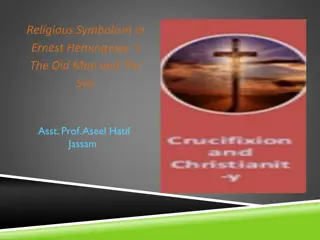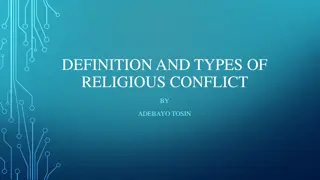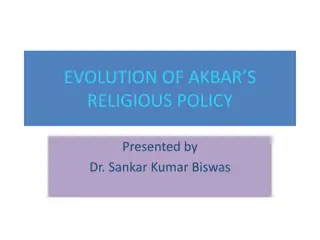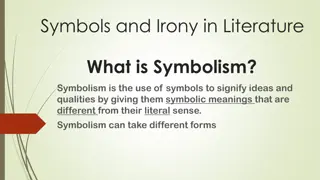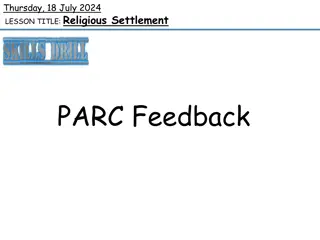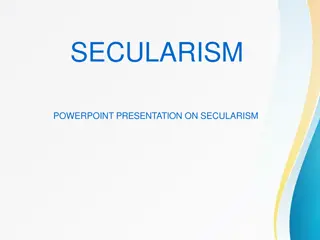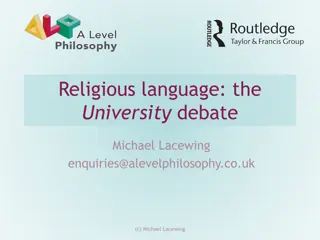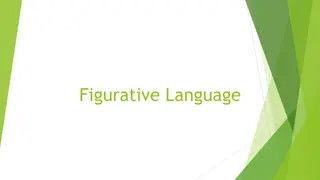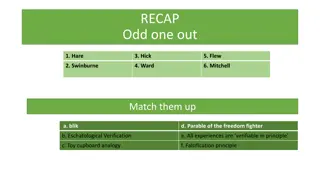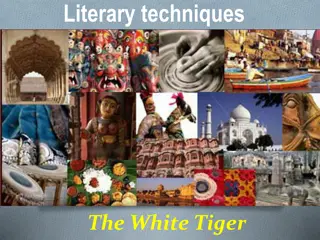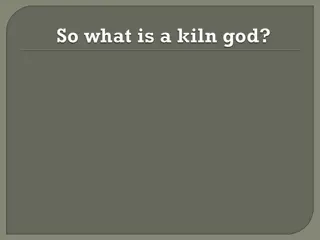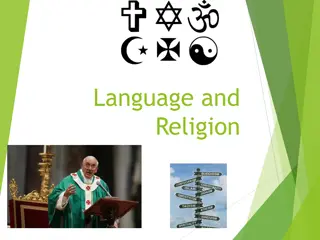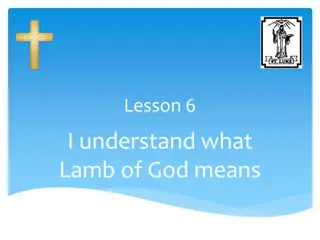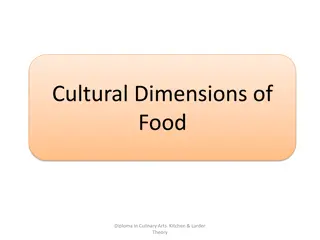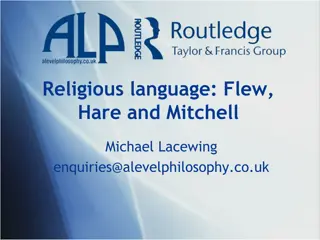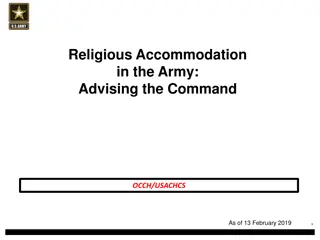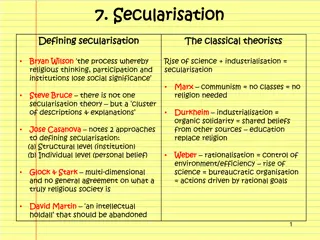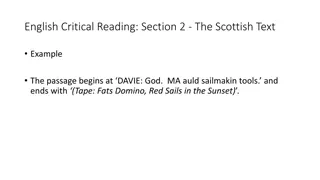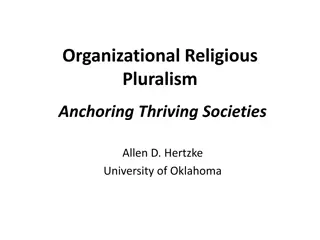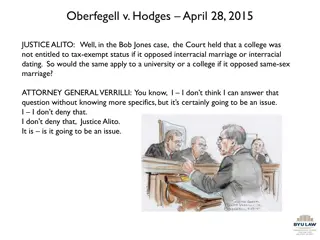Understanding Symbolism in Religious Language
Explore the use of symbols in religious language through the perspectives of John Randall and Paul Tillich. Discover how symbols function in conveying metaphysical realities, and consider the challenges of symbol adequacy in understanding religious teachings.
Download Presentation

Please find below an Image/Link to download the presentation.
The content on the website is provided AS IS for your information and personal use only. It may not be sold, licensed, or shared on other websites without obtaining consent from the author. Download presentation by click this link. If you encounter any issues during the download, it is possible that the publisher has removed the file from their server.
E N D
Presentation Transcript
DIL check 1. Complete all the tasks in the booklet up to page 10 Summary of analogy 2. Write a one page revision summary of Religious language as non- cognitive and analogical - Include an explanation of Analogy of Being why can we make a comparison between God and humanity. 3. Write an essay plan for Explain the concept of religious language as an analogy. 20 marks 4. Complete the Christianity Theme 1 knowledge test
Symbols tillich
Religious language as non-cognitive and symbolic: Functions of symbols (John Randall); God as that which concerns us ultimately (Paul Tillich). Challenges including whether a symbol is adequate or gives the right insights. A consideration of how these two views (Randall/Tillich) can be used to help understand religious teachings
1. What are signs and symbols? Discuss a definition Symbols A pattern or object which points to an invisible metaphysical reality.. Or they identify by: Pointing to a concept they are conveying Symbols may be pictorial, abstract, signs or metaphors Signs are arbitrary representations e.g.
Question 2 Using the next three slides Identify the 3 religious symbols and explain what they mean or stand for
Complete the rest of task 8 Use these pictures to help you explain the symbolism of a national flag
Lesson 2 Learning objective Analyse different concepts of RL Learning Outcomes To know Tillich s ideas on God which concerns us ultimately including his six key features of symbolic language To know Randall s fourfold function of symbols To evaluate and prioritise strengths and challenges to symbolic language
The purpose of symbols in religion Read the points below and turn them into a paragraph about symbols They are a non-cognitive way of using language to refer to religious figures etc. It s a way of describing God, (who may or may not be reality) They allow for the sharing of a concepts relevant to particular faiths i.e. baptism The concept of Christian baptism uses water-to convey the belief that it cleanses from original sin-this is symbolic
Randall The function of symbols E B C C
Now read page 10 Introduce Tillich into your work What is the different between a sign and a symbol give examples
Tillich identifies six key features of symbols: (a) They point to something beyond themselves, (b) They participate in that to which they point, (c) They open up levels of reality which otherwise are closed to us, and (d) They open up dimensions of the soul which correspond to those aspects of reality. (e) Symbols are not planned but develop out of individual/collective unconscious (f) Symbols grow when the situation is right for them, and they die when the situation changes
Tillichs ideas on symbols 1. Point beyond ____________ 2. ___________ in that to which they point 3. Opens up new ______ of _____ 4. Opens up parts of the _____ 5. Developed ___ __________ 6. Grow and then ________
Tillichs ideas on symbols 1. Point beyond themselves 2. Participate in that to which they point 3. Opens up new levels of reality 4. Opens up parts of the soul 5. Developed not planned 6. Grow and then die Add paragraphs to your essay on Randall and Tillich
Symbols in Christian scripture-Symbolic interpretation of scripture Scripture/Holy books can be interpreted symbolically, this means the words might actually mean something else, they represent a different truth. This symbolic interpretation of text/scripture is Liberal- because it is open to interpretation. Meaning- people read into it what they believe to be true.
1 Symbolic text - Parables The parable of the mustard seed (Luke 13.18; Matthew 13.31-32; Mark 4.30-32) The parable of the yeast (Luke 13, 20; Matthew 13.33) There are many more! They are very symbolic and they are open to interpretation
1 Activity : parables 1. How do you interpret Jesus message? 2. In what way the parable is symbolic?
2 A symbolic view of creation Some Christians see the creation account to be symbolically true an aetiological myth They believe that scientific explanations (e.g. Big Bang) can enhance their view of creation and God. To support their symbolic viewpoint, they scrutinise inaccuracies and contradictions. Hindu beliefs about creation see textbook
3 Another example to use miracles Miracles can be interpreted symbolically not literally true but showing something about God/Jesus Walking on the water Did Jesus walk on water, or was it due to a freak cold spell that created ice on the sea? Some scientists believe this is possible.
3 The miracles of Jesus The raising of Lazarus from the dead Did it really happen? Could Lazarus have been buried alive? Perhaps Jesus applied some kind of CPR?
Randall - Functions of symbols Randall claimed religious language can be seen as symbolic and has a four fold function 1. Arouse emotions and can lead to action 2. Stimulate cooperative behaviour and bind communities 3. Communicate aspects of experience that can be explained literally 4. Help us to understand our experience of the Divine
Challenges to symbolic interpretation of RL Read the criticisms For each criticism write a summary in your own words and an evaluation of its success Success Criteria Moving on from listing weaknesses to being able to evaluate them. This is a very important skill at A2
Tillich identifies six key features of symbols: (a) They point to something beyond themselves, (b) They participate in that to which they point, (c) They open up levels of reality which otherwise are closed to us, and (d) They open up dimensions of the soul which correspond to those aspects of reality. (e) Symbols are not planned but develop out of individual/collective unconscious (f) Symbols grow when the situation is right for them, and they die when the situation changes
Write an essay plan for Explain the concept of religious language symbolic What would you include? What scholars? What examples? What order would you write it in?


